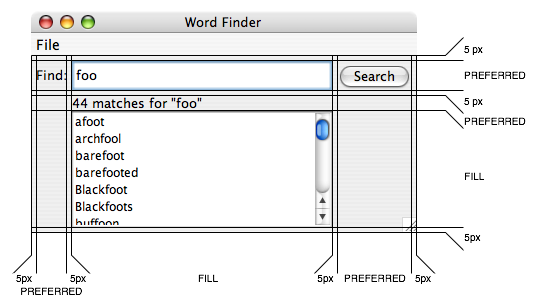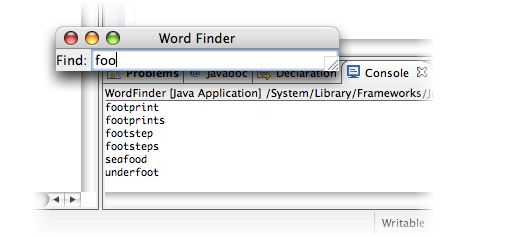
In this lab, you will become familiar with GUI programming and the Java Swing user interface toolkit. You will learn about:
Swing, and graphical user interface programming in general, is filled with complex APIs and complicated control flow mechanisms. This lab should give you the basic tools you need to complete your GUI in Project 3.
Before starting this lab, please do the following:
Word Finder will be a simple application that presents a basic but functional interface for searching a list of words.
The skeleton of this application is provided for you as follows:
Begin by running the main methods in WordList — it should output a list of words containing "ph" — and WordFinder, which should display a very preliminary UI.
Task 1: Add an ActionListener to the find JTextField so that pressing "enter" uses words to search for the current text in the field and display the results on the console (i.e., System.out).

A LayoutManger determines how components within a container like JFrame are arranged. The default LayoutManger for JFrames, BorderLayout, is simple but not very powerful. Java provides several other layout managers, some of which are notoriously complicated.
TableLayout is the alternative we will use for this lab, and which you are encouraged to use for the project. Read the documentation and this tutorial.
TableLayout arranges the user interface in a logical table of cells. A 2D array of doubles is used to specify the percentage or absolute width and height of the columns and rows of the table.
We would like to lay out the final interface of the Word Finder application like this:

In this diagram, PREFERRED indicates that the width or height of the column or row is determined by the "preferred" size of the components in it, and FILL indicates that the column or row expands to take up any remaining space when the window is shown or its size is changed by the user.
Task 2: Set the JFrame's layout manager to an appropriately-initialized TableLayout. Update the add(...) component calls to replace the BorderLayout information with the "column, row" String used by TableLayout.
A JList is the appropriate component to display the list of matched words. A JList separates the presentation of those words from the list itself by having a separate ListModel. For this lab, you can safely use a DefaultListModel, and add or remove items from this model as needed.
Task 3: Add to the window a JList contained inside a JScrollPane. Modify your code so that instead of outputting the matched words to the console, they appear in the scrollable list.
JScrollPane provides scrolling behavior for components that are too large to display in their entirety and is one example of how the view hierarchy (JList inside JScrollPane inside JFrame) is used to control component display.
Task 4: In addition to the list of results, it is also useful to know the number of matched words. Add a JLabel to your interface that is updated after every search to display the number of matches.
It is essential to organize your implementation so that actions are separated from the particular GUI components that trigger them.
Task 5: Add a "Search" button to the interface so that in addition to pressing "enter," the user can click "search" to update the list of matched words. If necessary, refactor your implementation so that code is not duplicated. At the same time, you should also ensure that when the interface is first displayed, it is identical to what appears when the user searches for the empty string.
Finally, no interface would be complete without a good old fashioned menu bar. And no user interface toolkit would be complete without providing standard dialogs for actions that ought to be consistent across applications, such as choosing a file from the disk. We'll put both of those features to use.
Task 6: Give your interface a JMenuBar with a "File" JMenu. On this menu, have at least two options:
The Javadoc documentation for JFileChooser includes an example that should make this task straightforward. JOptionPane is another important source for standard dialog boxes.
Task 7: You choose...
To finish off this simple Word Finder interface, implement one more feature of your choosing, as time in the lab permits. This can be anything you like; here are some suggestions: